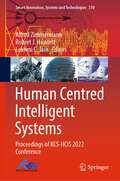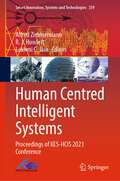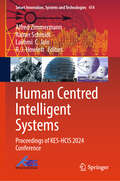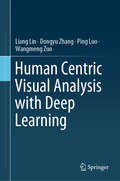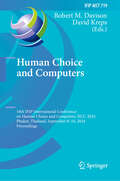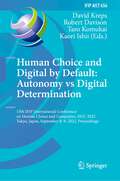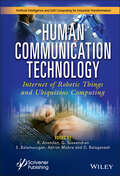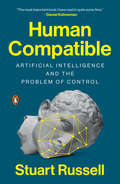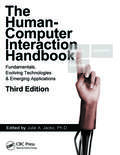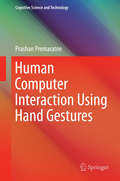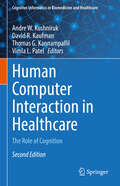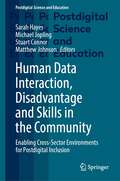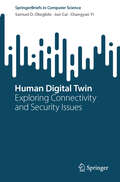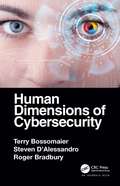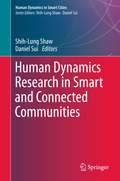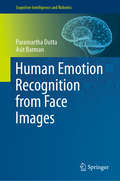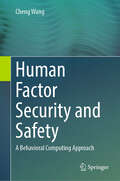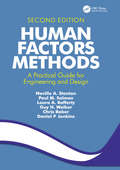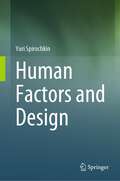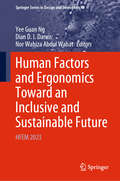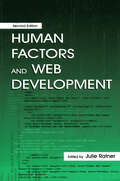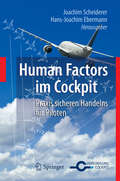- Table View
- List View
Human Centred Intelligent Systems: Proceedings of KES-HCIS 2022 Conference (Smart Innovation, Systems and Technologies #310)
by Lakhmi C. Jain Robert J. Howlett Alfred ZimmermannThe volume includes papers presented at the International KES Conference on Human Centred Intelligent Systems 2022 (KES HCIS 2022), held in Rhodes, Greece on June 20–22, 2022. This book highlights new trends and challenges in intelligent systems, which play an important part in the digital transformation of many areas of science and practice. It includes papers offering a deeper understanding of the human-centred perspective on artificial intelligence, of intelligent value co-creation, ethics, value-oriented digital models, transparency, and intelligent digital architectures and engineering to support digital services and intelligent systems, the transformation of structures in digital businesses and intelligent systems based on human practices, as well as the study of interaction and the co-adaptation of humans and systems.
Human Centred Intelligent Systems: Proceedings of KES-HCIS 2023 Conference (Smart Innovation, Systems and Technologies #359)
by Lakhmi C. Jain Alfred Zimmermann R. J. HowlettThe volume includes papers presented at the International KES Conference on Human Centred Intelligent Systems 2023 (KES HCIS 2023), held in Rome, Italy on June 14–16, 2023. This book highlights new trends and challenges in intelligent systems, which play an important part in the digital transformation of many areas of science and practice. It includes papers offering a deeper understanding of the human-centred perspective on artificial intelligence, of intelligent value co-creation, ethics, value-oriented digital models, transparency, and intelligent digital architectures and engineering to support digital services and intelligent systems, the transformation of structures in digital businesses and intelligent systems based on human practices, as well as the study of interaction and the co-adaptation of humans and systems.
Human Centred Intelligent Systems: Proceedings of KES-HCIS 2024 Conference (Smart Innovation, Systems and Technologies #414)
by Lakhmi C. Jain Rainer Schmidt Alfred Zimmermann R. J. HowlettThe volume includes papers presented at the International KES Conference on Human Centred Intelligent Systems 2024 (KES HCIS 2024), held in Madeira, Portugal on June 19–21, 2024. This book highlights new trends and challenges in intelligent systems, which play an important part in the digital transformation of many areas of science and practice. It includes papers offering a deeper understanding of the human-centred perspective on artificial intelligence, of intelligent value co-creation, ethics, value-oriented digital models, transparency, and intelligent digital architectures and engineering to support digital services and intelligent systems, the transformation of structures in digital businesses and intelligent systems based on human practices, as well as the study of interaction and the co-adaptation of humans and systems.
Human Centric Visual Analysis with Deep Learning
by Wangmeng Zuo Liang Lin Dongyu Zhang Ping LuoThis book introduces the applications of deep learning in various human centric visual analysis tasks, including classical ones like face detection and alignment and some newly rising tasks like fashion clothing parsing. Starting from an overview of current research in human centric visual analysis, the book then presents a tutorial of basic concepts and techniques of deep learning. In addition, the book systematically investigates the main human centric analysis tasks of different levels, ranging from detection and segmentation to parsing and higher-level understanding. At last, it presents the state-of-the-art solutions based on deep learning for every task, as well as providing sufficient references and extensive discussions. Specifically, this book addresses four important research topics, including 1) localizing persons in images, such as face and pedestrian detection; 2) parsing persons in details, such as human pose and clothing parsing, 3) identifying and verifying persons, such as face and human identification, and 4) high-level human centric tasks, such as person attributes and human activity understanding. This book can serve as reading material and reference text for academic professors / students or industrial engineers working in the field of vision surveillance, biometrics, and human-computer interaction, where human centric visual analysis are indispensable in analysing human identity, pose, attributes, and behaviours for further understanding.
Human Choice and Computers: 16th IFIP International Conference on Human Choice and Computers, HCC 2024, Phuket, Thailand, September 8–10, 2024, Proceedings (IFIP Advances in Information and Communication Technology #719)
by David Kreps Robert M. DavisonThis book constitutes the refereed proceedings of the 16th IFIP International Conference on Human Choice and Computers, HCC 2024, held in Phuket, Thailand, during September 8–10, 2024. The 9 full papers presented in this book were carefully reviewed and selected from 17 submissions. Summaries of 2 keynote presentations are also included. This papers focus on Humans, Technological Innovations and Artificial Intelligence: Opportunities and Consequences.
Human Choice and Digital by Default: 15th IFIP International Conference on Human Choice and Computers, HCC 2022, Tokyo, Japan, September 8–9, 2022, Proceedings (IFIP Advances in Information and Communication Technology #656)
by David Kreps Robert Davison Taro Komukai Kaori IshiiThis book constitutes the refereed proceedings of the 15th IFIP TC 9 International Conference on Human Choice and Computers, HCC15 2022, in Tokyo, Japan, in September 2022.The 17 full papers presented were carefully reviewed and selected from 32 submissions. Summaries of 2 keynote presentations are also included. The papers deal with the constantly evolving intimate relationship between humans and technology.
Human Communication Technology: Internet-of-Robotic-Things and Ubiquitous Computing (Artificial Intelligence and Soft Computing for Industrial Transformation)
by S. Balamurugan G. Suseendran D. Balaganesh Ashish Mishra R. AnandanHUMAN COMMUNICATION TECHNOLOGY A unique book explaining how perception, location, communication, cognition, computation, networking, propulsion, integration of federated Internet of Robotic Things (IoRT) and digital platforms are important components of new-generation IoRT applications through continuous, real-time interaction with the world. The 16 chapters in this book discuss new architectures, networking paradigms, trustworthy structures, and platforms for the integration of applications across various business and industrial domains that are needed for the emergence of intelligent things (static or mobile) in collaborative autonomous fleets. These new apps speed up the progress of paradigms of autonomous system design and the proliferation of the Internet of Robotic Things (IoRT). Collaborative robotic things can communicate with other things in the IoRT, learn independently, interact securely with the world, people, and other things, and acquire characteristics that make them self-maintaining, self-aware, self-healing, and fail-safe operational. Due to the ubiquitous nature of collaborative robotic things, the IoRT, which binds together the sensors and the objects of robotic things, is gaining popularity. Therefore, the information contained in this book will provide readers with a better understanding of this interdisciplinary field. Audience Researchers in various fields including computer science, IoT, artificial intelligence, machine learning, and big data analytics.
Human Compatible: Artificial Intelligence and the Problem of Control
by Stuart Russell"The most important book I have read in quite some time" (Daniel Kahneman); "A must-read" (Max Tegmark); "The book we've all been waiting for" (Sam Harris)A leading artificial intelligence researcher lays out a new approach to AI that will enable us to coexist successfully with increasingly intelligent machinesLonglisted for the 2019 Financial Times/McKinsey Business Book of the Year AwardIn the popular imagination, superhuman artificial intelligence is an approaching tidal wave that threatens not just jobs and human relationships, but civilization itself. Conflict between humans and machines is seen as inevitable and its outcome all too predictable. In this groundbreaking book, distinguished AI researcher Stuart Russell argues that this scenario can be avoided, but only if we rethink AI from the ground up. Russell begins by exploring the idea of intelligence in humans and in machines. He describes the near-term benefits we can expect, from intelligent personal assistants to vastly accelerated scientific research, and outlines the AI breakthroughs that still have to happen before we reach superhuman AI. He also spells out the ways humans are already finding to misuse AI, from lethal autonomous weapons to viral sabotage. If the predicted breakthroughs occur and superhuman AI emerges, we will have created entities far more powerful than ourselves. How can we ensure they never, ever, have power over us? Russell suggests that we can rebuild AI on a new foundation, according to which machines are designed to be inherently uncertain about the human preferences they are required to satisfy. Such machines would be humble, altruistic, and committed to pursue our objectives, not theirs. This new foundation would allow us to create machines that are provably deferential and provably beneficial.In a 2014 editorial co-authored with Stephen Hawking, Russell wrote, "Success in creating AI would be the biggest event in human history. Unfortunately, it might also be the last." Solving the problem of control over AI is not just possible; it is the key that unlocks a future of unlimited promise.
Human Computer Interaction Handbook: Fundamentals, Evolving Technologies, and Emerging Applications, Third Edition (Human Factors and Ergonomics)
by Julie A. JackoWinner of a 2013 CHOICE Outstanding Academic Title Award The third edition of a groundbreaking reference, The Human-Computer Interaction Handbook: Fundamentals, Evolving Technologies, and Emerging Applications raises the bar for handbooks in this field. It is the largest, most complete compilation of HCI theories, principles, advances, case st
Human Computer Interaction Using Hand Gestures
by Prashan PremaratneHuman computer interaction (HCI) plays a vital role in bridging the 'Digital Divide', bringing people closer to consumer electronics control in the 'lounge'. Keyboards and mouse or remotes do alienate old and new generations alike from control interfaces. Hand Gesture Recognition systems bring hope of connecting people with machines in a natural way. This will lead to consumers being able to use their hands naturally to communicate with any electronic equipment in their 'lounge. ' This monograph will include the state of the art hand gesture recognition approaches and how they evolved from their inception. The author would also detail his research in this area for the past 8 years and how the future might turn out to be using HCI. This monograph will serve as a valuable guide for researchers (who would endeavour into) in the world of HCI.
Human Computer Interaction in Healthcare: The Role of Cognition (Cognitive Informatics in Biomedicine and Healthcare)
by Vimla L. Patel Thomas G. Kannampallil David R. Kaufman Andre W. KushnirukThis thoroughly updated edition reports on the current state of human computer interaction (HCI) in biomedicine and healthcare, focusing on the cognitive underpinnings of human interactions with people and technology. With health information technologies becoming increasingly vital tools for the practice of clinical medicine, this book draws from key theories, models and evaluation frameworks, and their application in biomedical contexts to apply this to current research in HCI. However, numerous challenges remain in order to fully realize their potential as instruments for advancing clinical care and enhancing patient safety. There is a general consensus that health IT has not realized its potential as a tool to facilitate clinical decision-making, the coordination of care and improvements in patient safety. Embracing sound principles of iterative design can yield significant dividends. It can also enhance practitioner’s abilities to meet “meaningful use” requirements. The purpose of the book is two-fold: to address key gaps on the applicability of theories, models and evaluation frameworks of HCI and human factors for research in biomedical informatics. It highlights the state of the art, drawing from the current research in HCI. It also serves as a graduate level textbook highlighting key topics in HCI relevant for biomedical informatics, computer science and social science students working in the healthcare domain. Cognitive Informatics for Biomedicine: Human Computer Interaction in Healthcare is indispensable to those who want to ensure that the systems they build, and the interactive environments that they promote, will reflect the rigor and dedication to human-computer interaction principles that will ultimately enhance both the user’s experience and the quality and safety of the care that is offered to patients. It is an essential reference to all who are interested in the application of these new techniques within healthcare, from students of informatics through to clinicians, informatics researchers and developers of health IT looking to incorporate them into their day-to-day workflow.
Human Data Interaction, Disadvantage and Skills in the Community: Enabling Cross-Sector Environments for Postdigital Inclusion (Postdigital Science and Education)
by Sarah Hayes Matthew Johnson Stuart Connor Michael JoplingThe book provides a dynamic, cross-sectional, multidisciplinary perspective and dialogue to illuminate the challenges humans face in their interactions with data in their individual postdigital contexts in local communities. It offers unique insights from real cases, collaborations, and projects to extend existing academic theories and frameworks, applied to human data interactions, disadvantage, and digital skills. The book takes the novel approach of establishing co-authorship between cross-sector practitioners from the wider community (such as local authorities, councils, policy makers, small businesses, charities, education and skills providers, and other stakeholders) with international academics and researchers who write about humans, digital skills, and data. This develops an enabling cross-sector environment throughout the book that not only furthers broader understandings concerning data, disadvantage and digital skills in postdigital society, but also shares a template to support others who may wish to adopt this approach to co-authorship and knowledge exchange.The book revisits the Human Data Interaction (HDI) framework (Mortier, Haddadi, Henderson, McAuley, and Crowcroft 2014) through many diverse cross-sectoral perspectives. These are co-authored under the HDI framework’s key tenets of: agency, legibility, negotiability and resistance. These tenets form the main sections of the book, with chapters examining these concepts through both interdisciplinary academic literature and cross-sector dialogue with individuals and agencies from the wider community who work with diverse and often disadvantaged groups.
Human Digital Twin: Exploring Connectivity and Security Issues (SpringerBriefs in Computer Science)
by Changyan Yi Jun Cai Samuel D. OkegbileHuman digital twin (HDT) is a transformative technology poised to transform various human-centric systems. With its potential applications in personalized healthcare, HDT promises swift, precise, and efficient healthcare services through the integration of cutting-edge technologies such as artificial intelligence, data analytics, internet of things, cybersecurity as well as virtual and augmented reality. This book addresses the critical gap in the existing literature by offering a comprehensive exploration of connectivity solutions for HDT while prioritizing reliability, security, and privacy. Key topics covered include the foundational concept of HDT, its design requirements and associated challenges, edge-assisted human-to-virtual solutions, blockchain-enabled data-sharing mechanisms, and differentially private federated multi-task learning (DPFML) methodologies tailored for HDT.The discussion on the concept of HDT encompasses an overview of its applications and its specific characteristics when compared to the conventional digital twin models. In addressing the design requirements and challenges of HDT, the text delves into the complexities of securing high-quality data, ensuring ultra-reliable and low-latency communication, data privacy and integrity, while managing storage, computation and analytics. Exploring edge-assisted human-to-virtual solutions, the book also introduces a connectivity framework and details the modeling process for human-to-virtual twin connectivity. The book later presents an in-depth examination of the practical Byzantine fault tolerance framework, followed by a discussion on shard-based Byzantine fault-tolerant schemes tailored for HDT, along with analyses of latency and throughput.Furthermore, the book outlines the framework for DPFML-assisted human-to-virtual twin connectivity, accompanied by a novel consensus algorithm known as the proof of model quality. Finally, it presents future research directions aimed at addressing communication challenges hindering the seamless design and development of HDT. By offering this comprehensive exploration, the book serves as a valuable resource for researchers, practitioners, and policymakers seeking to navigate the evolving landscape of HDT and its transformative potential in various domains.
Human Dimensions of Cybersecurity
by Terry Bossomaier Steven D'Alessandro Roger Bradbury"In Human Dimensions of Cyber Security, Terry Bossomaier, Steven D’Alessandro, and Roger Bradbury have produced a book that … shows how it is indeed possible to achieve what we all need; a multidisciplinary, rigorously researched and argued, and above all accessible account of cybersecurity — what it is, why it matters, and how to do it." --Professor Paul Cornish, Visiting Professor, LSE IDEAS, London School of Economics Human Dimensions of Cybersecurity explores social science influences on cybersecurity. It demonstrates how social science perspectives can enable the ability to see many hazards in cybersecurity. It emphasizes the need for a multidisciplinary approach, as cybersecurity has become a fundamental issue of risk management for individuals, at work, and with government and nation states. This book explains the issues of cybersecurity with rigor, but also in simple language, so individuals can see how they can address these issues and risks. The book provides simple suggestions, or cybernuggets, that individuals can follow to learn the dos and don’ts of cybersecurity. The book also identifies the most important human and social factors that affect cybersecurity. It illustrates each factor, using case studies, and examines possible solutions from both technical and human acceptability viewpoints.
Human Dynamics Research in Smart and Connected Communities
by Daniel Sui Shih-Lung ShawThis book addresses how accelerating advances in information and communication technology, mobile technology, and location-aware technology have fundamentally changed the ways how social, political, economic and transportation systems work in today’s globally connected world. It delivers on many exciting research questions related to human dynamics at both disaggregate and aggregate levels that attract the attention of researchers from a wide range of disciplines. Human Dynamics Research involves theoretical perspectives, space-time analytics, modeling human dynamics, urban analytics, social media and big data, travel dynamics, privacy issues, development of smart cities, and problems and prospects of human dynamics research. This book includes contributions on theoretical, technical, or application aspects of human dynamics research from different disciplines. Appealing to researchers, scholars and students across a wide range of topics and disciplines including: urban studies, space-time, mobility and the internet, social media, big data, behavioral geography and spatio-temporal-network visualization, this book offers a glimpse at the cutting edge of research on human dynamics.
Human Emotion Recognition from Face Images (Cognitive Intelligence and Robotics)
by Paramartha Dutta Asit BarmanThis book discusses human emotion recognition from face images using different modalities, highlighting key topics in facial expression recognition, such as the grid formation, distance signature, shape signature, texture signature, feature selection, classifier design, and the combination of signatures to improve emotion recognition. The book explains how six basic human emotions can be recognized in various face images of the same person, as well as those available from benchmark face image databases like CK+, JAFFE, MMI, and MUG. The authors present the concept of signatures for different characteristics such as distance and shape texture, and describe the use of associated stability indices as features, supplementing the feature set with statistical parameters such as range, skewedness, kurtosis, and entropy. In addition, they demonstrate that experiments with such feature choices offer impressive results, and that performance can be further improved by combining the signatures rather than using them individually.There is an increasing demand for emotion recognition in diverse fields, including psychotherapy, biomedicine, and security in government, public and private agencies. This book offers a valuable resource for researchers working in these areas.
Human Entanglement Theory: A Quantum Approach to the Study of All-Encompassing Human Communication
by Christian AspalterThis innovative book has combined the latest drive to integrate the findings and principles of quantum mechanics and quantum technology, especially here quantum computing, into the flamboyant world of social sciences. Starting with Friedrich Nietzsche as a role model, especially his “Human, All-too-Human,” the book explores the world of interpersonal and intrapersonal, intercultural and transhistorical, human communication. This book uses an innovative experiential and abductive research design. The philosophy inspired by Nietzsche meets new inspirations stemming from quantum mechanics and quantum computing in particular. Building on derived guiding principles of (fuzzy) randomness, parallelity, and universality (with communication, words and feelings, as the least common denominator), the book arrives at the formation of a new quantum-inspired theory, called the Theory of Human Entanglement, where entanglements are causal forces for human communication (and hence human actions) that either instigate and propel, or inhibit and stifle human communication (and thus human actions). Human entanglements are diverse; they are complex and accumulative in nature. They operate in a multi-dimensional space, encompassing language usage (including their hidden connotations and culturally constructed truths, such as hidden notions of good and evil, allowed and forbidden), cultural traditions and limitations, governance, institutions, court rulings and practices, particular usages of common sense, local/neighborhood culture and practices, socio-economic and environmental forces and limitations, personal situations and experiences, personal thoughts, feelings, memories and aspirations, and much more. The theory may serve as starting point for greater causality focus in research design and applications across all social sciences and far beyond, especially when dealing with high number or infinite number of potentially causal and causal variables, as well as their aggregate forces (i.e. probability-based vector forces). On top, artificial intelligence applications, quantum information, and quantum finance applications, for example, may contribute to the further development of human entanglement theory, and vice versa.
Human Factor Security and Safety: A Behavioral Computing Approach
by Cheng WangAs we navigate an increasingly complex digital landscape, ensuring human factor security and safety has never been more critical. This groundbreaking book offers an innovative perspective by leveraging behavioral computing to address challenges in human factor security across diverse scenarios. Through comprehensive coverage, the book introduces advanced methods like behavioral modeling and simulation to analyze multimodal behavioral data—spanning structure, language, and vision. These approaches not only deepen our understanding of human behavior but also enable robust solutions to modern security concerns, presenting a new paradigm for safeguarding systems in dynamic environments. Ideal for researchers, professionals, and advanced students in security technologies and behavioral sciences, this work bridges theoretical frameworks with practical applications. Key topics include the evolution of behavioral paradigms, the role of behavioral structures in simulation, and real-world applications in cyberfinance and human factor engineering.
Human Factors Analysis of 23 Cyberattacks (The Human Element in Smart and Intelligent Systems)
by Abbas MoallemAs cyber threat actors have become more sophisticated, data breaches, phishing attacks, and ransomware are increasing, and the global cybercrime damage in 2021 was $16.4 billion a day. While technical issue analyses are fundamental in understanding how to improve system security, analyzing the roles of human agents is crucial. Human Factors Analysis of 23 Cyberattacks addresses, through examples, the human factors behind cybersecurity attacks.Focusing on human factors in individual attack cases, this book aims to understand the primary behaviors that might result in the success of attacks. Each chapter looks at a series of cases describing the nature of the attack through the reports and reviews of the experts, followed by the role and human factors analysis. It investigates where a human agent's intervention was a factor in starting, discovering, monitoring, or suffering from the attacks. Written in an easy-to-understand way and free from technical jargon, the reader will develop a thorough understanding of why cyberattacks occur and how they can be mitigated by comparison to the practical examples provided.This title will appeal to students and practitioners in the fields of ergonomics, human factors, cybersecurity, computer engineering, industrial engineering, and computer science.
Human Factors Engineering and Ergonomics: A Systems Approach
by Stephen J. GuastelloThis textbook comprehensively covers the basic principles and most recent advances regarding visual displays, auditory and tactile displays and controls; psychophysics; cognitive processes; human-computer interaction, artificial intelligence and artificial life; stress and human performance; occupational accidents and prevention; human group dynamics and complex systems; and anthropometry, workspace and environmental design. The systems perspective emphasizes nonlinear dynamics for system performance changes and emergent behaviours of complex person-machine systems.This book- • Surveys principles of conventional and computer-based machine interaction. • Assesses the relative effectiveness of accident analysis and prevention strategies. • Highlights nonlinear dynamics for system performance changes. • Examines artificial intelligence and complex systems. • Investigates sources of cognitive workload and fatigue. The textbook will be a valuable resource for advanced undergraduates and graduate students in diverse fields including ergonomics, human factors, cognitive science, computer science, operations management, and psychology. The textbook brings together core principles of person-machine interaction, accident analysis and prevention strategies, risk analysis and resilience, artificial intelligence, group dynamics, and nonlinear dynamics for an enhanced understanding of complex person-machine systems.
Human Factors Methods: A Practical Guide for Engineering and Design
by Daniel P. Jenkins Neville A. Stanton Guy H. Walker Paul M. Salmon Laura A. Rafferty Chris BaberThis second edition of Human Factors Methods: A Practical Guide for Engineering and Design now presents 107 design and evaluation methods as well as numerous refinements to those that featured in the original. The book has been carefully designed to act as an ergonomics methods manual, aiding both students and practitioners. The eleven sections represent the different categories of ergonomics methods and techniques that can be used in the evaluation and design process. Offering a 'how-to' text on a substantial range of ergonomics methods that can be used in the design and evaluation of products and systems, it is a comprehensive point of reference for all these methods. An overview of the methods is presented in chapter one, with a methods matrix showing which can be used in conjunction. The following chapters detail the methods showing how to apply them in practice. Flowcharts, procedures and examples cover the requirements of a diverse audience and varied applications of the methods. The final chapter, a new addition, illustrates the EAST method, which integrates several well-known methods into a teamwork analysis approach.
Human Factors and Design
by Yuri SpirochkinThis book describes various manifestations of human factors when interacting with potentially dangerous technical systems: airplanes, launch vehicles and spaceships, nuclear power plants, energy-saturated ground vehicles and infrastructure facilities. The idea of the book arose from the desire to find a common ground between industries that are important for safety. Their similarity lies, in addition to the technological advancement of products and solutions, in equally high safety requirements, in particular taking into account the influence of human factor. Thus, it is of relevance to analyze an impact of human factor in the context of safety. The matter is rather complex: on the one hand humans manage technical systems, on the other hand human errors, negligence or evil intentions can turn the system into a threat with disastrous consequences. However, human interaction with any technical system begins earlier – in the design stage. In this stage, designer, being creator of the system, must ensure a safe operation and take into consideration possible risks, including those caused by human factors itself. The book is interdisciplinary in nature and intended mainly for designers of technical systems, aiming to assist the specialists in understanding the issues of human participation in life cycle of these systems. The examples given are intended to benefit from experiences of not one, but a number of industries.
Human Factors and Ergonomics Toward an Inclusive and Sustainable Future: HFEM 2023 (Springer Series in Design and Innovation #46)
by Yee Guan Ng Dian D. I. Daruis Nor Wahiza Abdul WahatThis book gathers the refereed proceedings of the 5th HFEM Biennial Conference on Human Factors and Ergonomics, organized by the Human Factors and Ergonomics Society Malaysia, held in Langkawi, Malaysia on August 13–18, 2023. Under the theme "Accelerating Human Factors and Ergonomics Toward an Inclusive and Sustainable Future", it highlights the latest theories and models, as well as cutting-edge technologies and applications on human factors and ergonomics. By combining findings from a range of disciplines including engineering, design, robotics, health care, management, computer science, human biology, and behavioral science, it offers an excellent source of innovative ideas to stimulate future discussions and developments aimed at applying knowledge and techniques to optimize system performance, while at the same time promoting the health, safety, and well-being of individuals. It includes papers from researchers and practitioners, scientists and physicians, institutional leaders, managers, and policy makers that contribute to constructing the human factors and ergonomics approach across a variety of methodologies, domains, and productive sectors.
Human Factors and Web Development
by Mark J. Anderson Patrick J. WhitcombDue to the ever-changing technological landscape and the global integration of the Internet in schools, libraries, homes, and businesses, the content of this second edition changed significantly. Since many computer users are connected at both home and work, the Web has transformed communication; consumption patterns; and access to business, politi
Human Factors im Cockpit
by Joachim Scheiderer Hans-Joachim EbermannDie Hauptaufgabe eines Verkehrspiloten besteht darin, sein Flugzeug sicher von A nach B zu bringen. Dabei ist das Wissen um eine optimale Unfallprävention noch immer verbesserungsfähig. In dem Buch wird dargelegt, wann und unter welchen Umständen Unfälle passieren und wie sie sich vermeiden lassen. Demnach dient insbesondere das Crew Ressource Management (CRM) der Unfallprävention. Die Autoren, fast ausnahmslos Verkehrspiloten, definieren die Prinzipien des CRM und zeigen anschließend auf, wie dessen Inhalte in die Praxis übertragen werden können.
